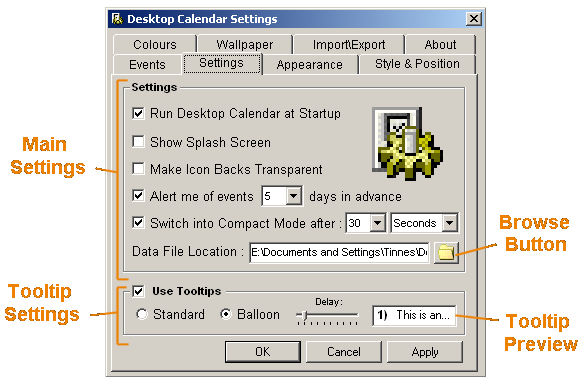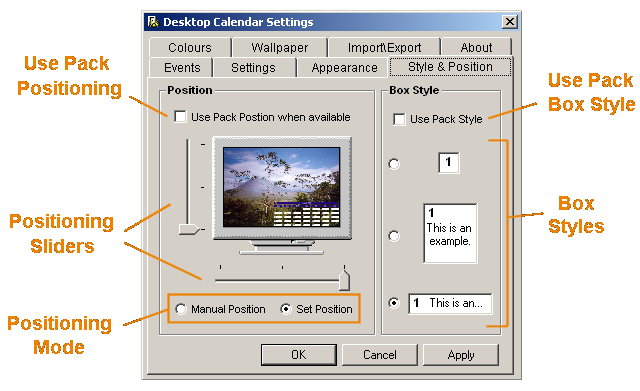 Version
Version
Select which version of the calendar you have
- Desktop Calendar 7
- Desktop Calendar 0.5
- FAQ
- Walkthrough
- Tips
- Hotkeys
- Installation
- Desktop Calendar 0.4
 Contact
Contact
Can't find the answer to your question here? Contact us.
Desktop Calendar 0.5 Walkthrough

Run Desktop Calendar at Startup - Makes the calendar load with Windows.
Splash Screen - Use this option to Disable\Enable the splash screen when DC loads...

Make Icon Backs Transparent - This option tries to make the back of your desktop icons transparent when running Windows 95, 98, 2000 or NT (Windows XP does it anyway). If you're still unsure what this means take a look at the example below. Note: This may not work on some machines and can sometimes conflict with the Use System Colours option.
Alert me of events X days in advance - With this option ticked you will be alerted events when the calendar is loaded or the next day rolls over. You can select how many days in advance you want to be alerted of events. If for example you select '5' then you'll be told of events that are up to five days away, and if you select '0' then you'll only be alerted of events for the current day.
Switch into Compact Mode after XX - Here you can select how long you want the calendar to be idle before it goes into compact mode. Of course you can un-tick this option and always keep the calendar open.
Data File Location - All your events are stored in a single file called "calendar.dat". By default the file is located in your Desktop Calendar directory. However click the Browse Button and you can choose which folder to read the data file in from.
For example if you had Windows set up for multiple logins, each person could set the data file location to a different folder (e.g. C:\Documents and Settings\xxxx\My Documents), thus allowing them each to have their own "calendar.dat" file and therefore their own set of events.
Tooltips - There are two types of Tooltips, 'Standard' and 'Balloon'. The Standard ones are very limited, they can only be one line high and you can't control the delay you have to hover over a day cells for them to appear. The Balloon tooltips however are more advanced. They will display your events in a multi-lined format and with the 'Delay Slide Bar' shown above, you can adjust the hover time. Alternatively, the tooltips can be turned off by removing the tick from the checkbox.

Box Styles - There are three different box styles each with their own advantages and disadvantages. First there is the square box style (middle). This is the largest of all the boxes spreading the events over three lines. Of course as it's the largest box style it also takes up the most room on the desktop. The thin box style (bottom) is smaller and takes up slightly less room then the square box. The disadvantage of this one is you only get one line so you see less of the event. Finally there is the mini box style (top). This is used when you want the calendar to take up a tiny amount of space. The problem with it of course is you can't see any of the events unless you use the tool tips or open an event up to be edited.
Use Pack Box Style - If this option is ticked, and a Wallpaper Pack is selected, then the box style for that specific pack will be used. You can turn this option off at anytime and the box style will return to the one you manually selected.
Positioning Mode - If manual positioning is selected then you are free to drag the calendar around the screen by holding down the left mouse button over the title bar. Once you've dragged it to the right place, release the mouse button. There are some disadvantages to manual positioning. If you have the calendar at the bottom of the screen and change down to a lower resolution, the calendar will be off the screen and won't be visible anymore! To fix this change back to the higher resolution and move the calendar closer to the top left corner of the screen, this should ensure that's it's still visible once you lower the resolution back down again. Alternatively you can use the 'Set Position' option. When you select this, the positioning sliders become active and you can use them to select where on the screen you want the calendar to be. Unlike manual position the calendar will update it's position when the screen changes e.g. when you lower the resolution or move the start bar.
Positioning Sliders - There are nine possible positions...
- Bottom Right
- Bottom Center
- Bottom Left
- Center Right
- Center Screen
- Center Left
- Top Right
- Top Center
- Top Left
Use Pack Positioning - If this option is ticked and a Wallpaper Pack is selected, then all the other positioning options are ignored. The calendar will get it's position directly from the Pack.

